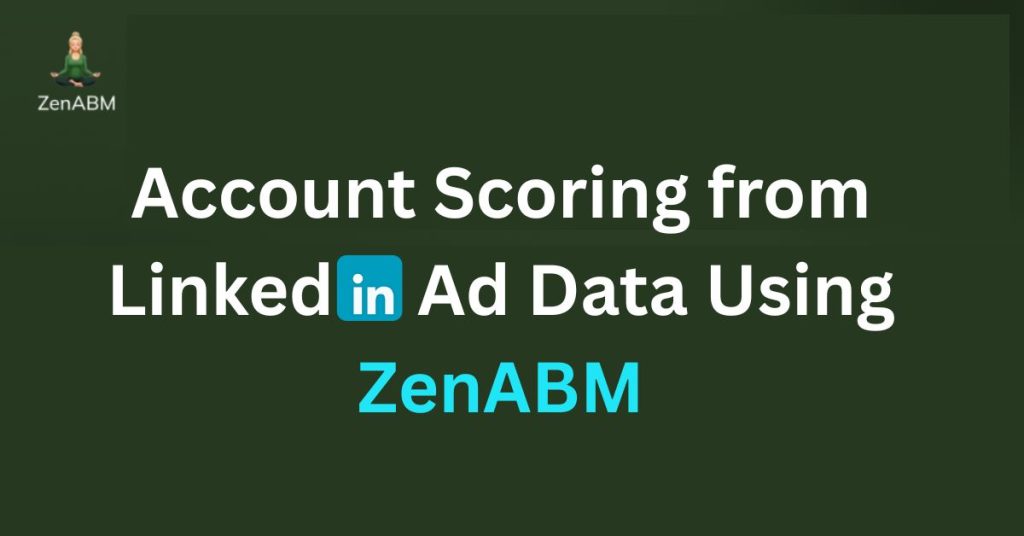Drowning in LinkedIn ad data without a clear way to turn it into action?
In this article, I show exactly how to build account scoring from LinkedIn ad data for ABM. I pulled the most consistent, field-tested guidance from social feeds and search results, then condensed it into practical steps.
And yes, ZenABM supports account scoring driven by LinkedIn signals, which I explain below.
Let’s get into it.
Account scoring from LinkedIn ad data: quick summary
- Account scoring powers ABM: Score entire companies to focus effort where conversion odds are highest. Only about ~5% of your market is actively buying at any moment, so the model helps you catch that slice in time.
- Clicks are only one piece: CTR alone is weak for ABM. LinkedIn CTR sits near 0.4–0.5%, which means most interested buyers never click. Cookie rules and IP lookup tools do not plug this gap. One real test surfaced 1 company out of 300 ad viewers, which shows how much intent you miss if you score only on clicks.
- Engagement equals intent on LinkedIn: The Companies report tells you which firms interact with your ads. If Acme keeps viewing or engaging with Product A creatives, that suggests active interest. Native reports roll up by ad account, not by individual campaign, so go deeper if you want true intent.
- Inputs that matter for scoring: Track impressions, engagements, and clicks, then layer in recency and frequency. Assign higher weights to deeper actions. The goal is to quantify intensity of interest at the account level.
- Model design in plain terms: Begin simple. Example weights: 1 for an impression, 5 for a click, 10 for a LinkedIn form fill. Add time decay after a quiet spell. Tune weights to your funnel. Use cumulative activity to surface hot accounts, and cool down stale ones.
- Automate the math in your CRM or MAP: Manual updates do not scale. Sync company-level engagement into properties like “LI Impressions Last 7 Days.” Recalculate scores and trigger alerts when thresholds fire. Native connectors are limited, so consider a purpose-built tool. With ZenABM, these fields update continuously.
- ZenABM simplifies the stack: It ingests company-level LinkedIn data via the API, computes a real-time account score, counts view-through, routes hot accounts to sales, tags engagement by campaign and intent, and syncs all of it back to your CRM as company properties.
Why account scoring matters in ABM
Account scoring is the backbone of a strong ABM strategy.
ABM is about precision, not volume. You operate with a finite target account list of potential high-value customers, and the job is to learn which companies are warming up and which can wait. Lead scoring that treats people in isolation misses the buying committee dynamic, so you need the account-level picture.
Timing is another reason scoring matters. Only about 5% of your market is in an active cycle at any point. If you can spot that 5% and notify sales in time, you win more often. Scoring aggregates signals such as ad engagement, site visits, and downloads to reveal when an account is heating up.
The outcome is simple. Sales calls accounts that already know you, not cold strangers who have never seen your name. Visits to your pricing page after a week of LinkedIn exposure are a classic pattern to prioritize.
Why traditional ad engagement metrics fall short for account scoring
LinkedIn Ads are ideal for ABM, since you can reach the right roles, but most of those people do not click. Average CTR is about 0.4 to 0.5%. 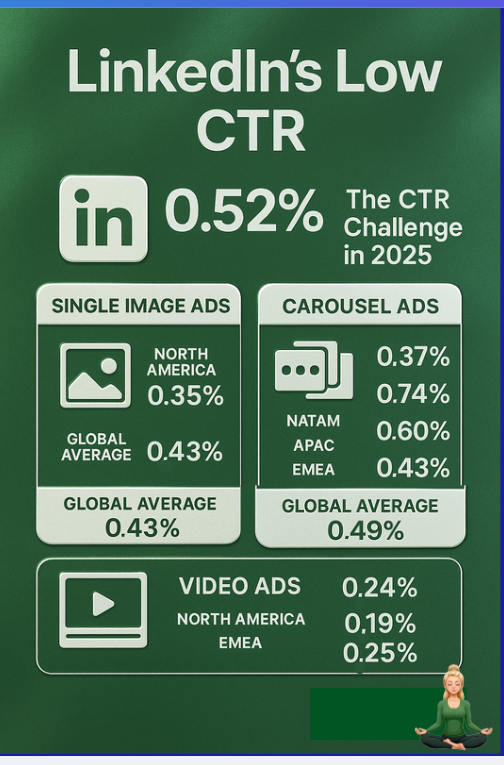
That means 199 out of 200 impressions generate no clicks.
Impact still happens. Many viewers search your brand later, reach your site via another channel, or respond to an email after repeated exposure. If you score only on direct clicks, those accounts look inactive, and LinkedIn appears to underperform.
Consider Acme on your target list. Five employees see your ads in a month without clicking. One searches for your tool a week later and visits your site. Another submits a demo form after an email. Last-touch analytics credit search or email, and a click-only score gives Acme zero, which hides real momentum. View-through matters in ABM because multiple people act at different times.
Teams try to compensate with tactics like:
- IP-based deanonymization to identify companies that visit after an ad. Accuracy is poor in B2B due to VPNs, shared networks, mobile devices, and unregistered IPs. A Userpilot case study inside a LinkedIn ABM campaign showed one recognized company out of 300 ad visitors, which came out to below 1%. Even stronger reports cite about ~40% match rates.

The takeaway: ABM needs an account-centric lens. Aggregate every meaningful interaction, including passive views, and score the whole company. That approach measures true engagement, not just the last click.
How LinkedIn ad analytics can signal account intent
Let’s zoom in on what LinkedIn provides today.
- Recent releases are useful for ABM, especially the Company Engagement Report, now visible as the Companies tab in Campaign Manager.
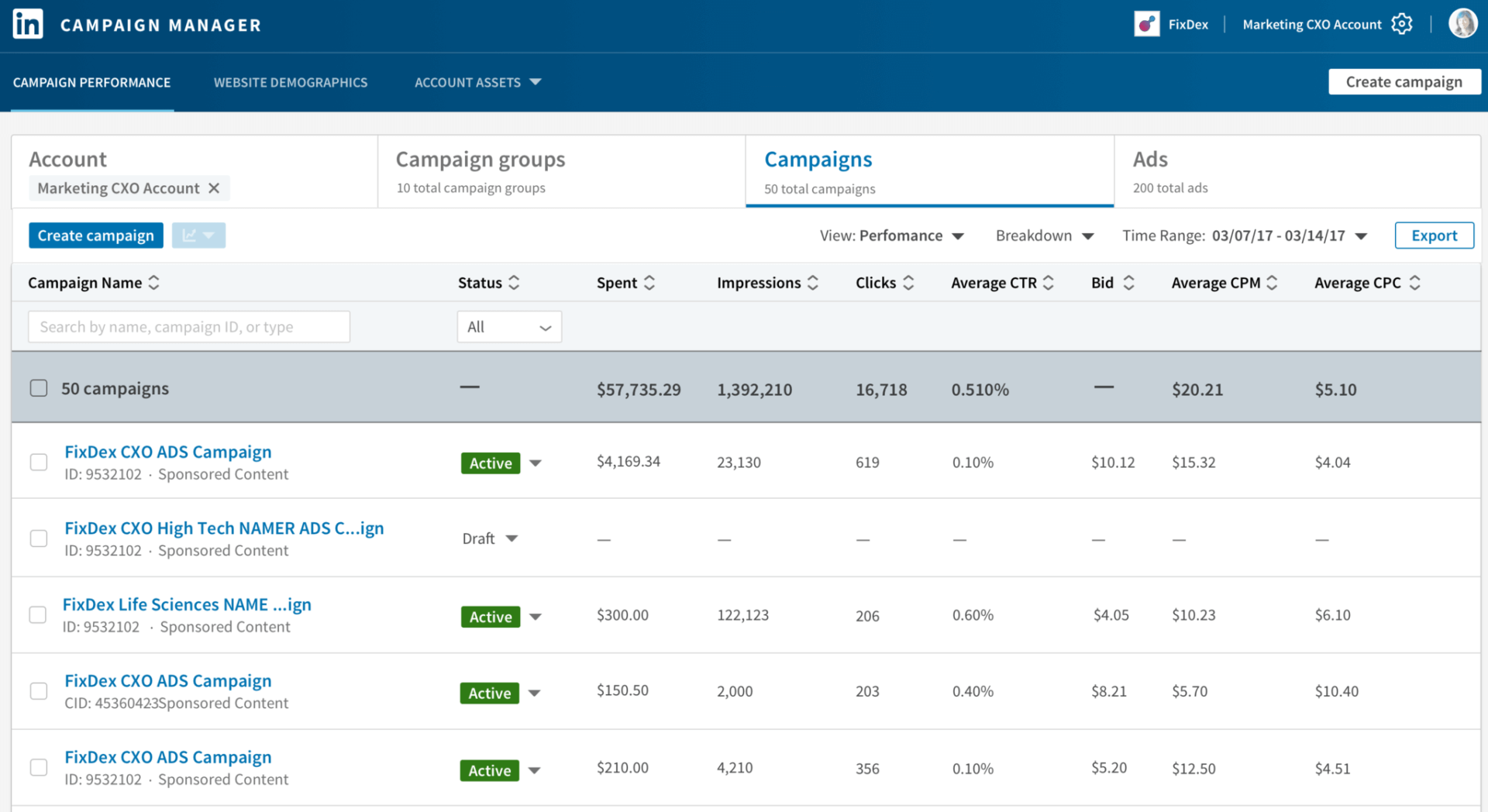
- This view lists impressions, clicks, and an overall engagement level for each company that interacted with your ads. It is a major improvement, since you can finally see which accounts saw or clicked.
- There is a catch: the Companies tab aggregates at the ad account level, which hides the specific campaign or message track that drew interest. If you promote Feature A and Feature B in separate campaigns and Acme appears in the list, you still do not know which theme resonated. Userpilot ran intent-based structures for exactly this reason:
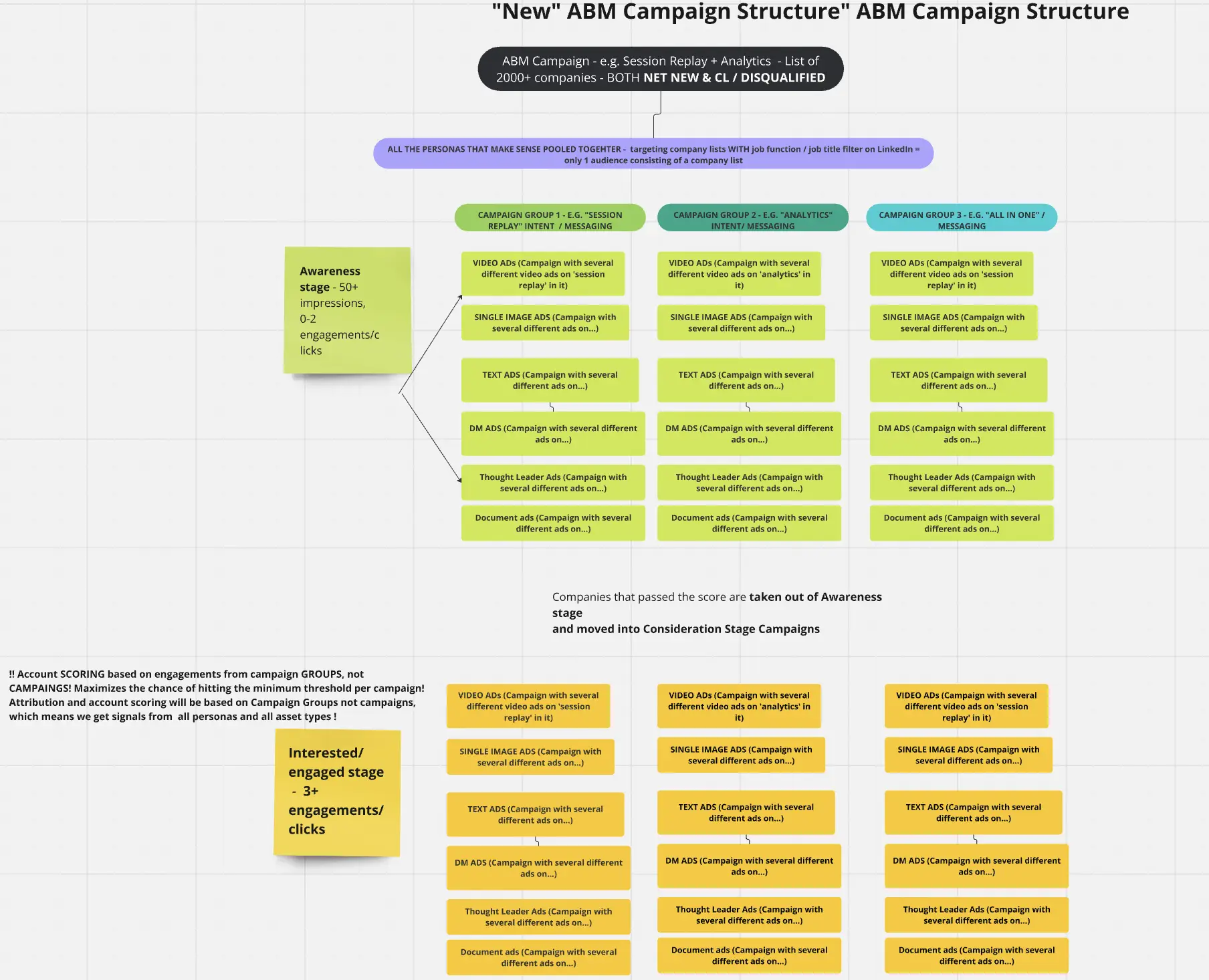 From an intent perspective, missing company-by-campaign detail is a big gap. Your reps would want to know if Acme gravitated to Feature A or Feature B to tailor outreach.
From an intent perspective, missing company-by-campaign detail is a big gap. Your reps would want to know if Acme gravitated to Feature A or Feature B to tailor outreach.- To use LinkedIn engagement as an intent signal, break results down by campaign and by creative. That requires granular reporting or an API-based pull. With the right tool (ZenABM), you get views like: Acme Corp, 15 impressions and 2 clicks on Campaign X for use case A, plus 7 impressions on Campaign Y for use case B.
- Watch for surges. Spikes such as 0 to 50 impressions in a week, or clusters of clicks, often point to a fresh internal project. Since the stimulus is your own media on LinkedIn, these intent signals qualify as first-party data.
LinkedIn ad analytics data points that matter most for account scoring
Not every metric carries the same weight.
When you build an account score from LinkedIn analytics, prioritize the following.
Impressions
This is your exposure baseline. High counts show repeated visibility, not intent. A sudden jump, especially with a frequency cap, may mean more people from the company entered your audience. Include impressions so the model captures view-through interest.
Clicks
Clicks indicate active interest. Treat them as higher value than impressions. Monitor CTR at the account level. For instance, 10 impressions with 3 clicks is unusually strong and should raise the score. The Companies tab lists clicks per company, and exports or API pulls let you compute CTR.
Engagements (reactions, comments, shares)
Public interactions suggest stronger resonance. Comments or multiple reactions should prompt sales follow-up. A simple Like can sit above a click in your weighting, since it signals on-platform content fit. These social actions are included in LinkedIn engagement totals and available via the API.
Lead generations (form fills)
Lead Gen Form submissions are among the strongest signals, often equal to or stronger than a demo request. The Companies tab shows lead counts for lead gen campaigns. One submission from a named account should lift the score significantly.
Spend or ads served
Spend is not a behavior, yet it reveals how aggressively you targeted the company. High spend with weak engagement signals waste. If you already include impressions, raw spend usually stays out of the formula and remains a diagnostic. Note: You can track all of this inside ZenABM.
Steps to design an account scoring model using LinkedIn ad analytics
Here is a practical path to building the score from LinkedIn ad data.
Step#1: Define your scoring inputs
Choose the metrics to include. Keep it tight. Start with impressions, clicks, and LinkedIn lead fills if you use Lead Gen Forms. You can add a combined engagement count later.
Step#2: Assign weights
Translate each metric into points. For example:
- 1 point per impression
- 5 points per click
- 10 points per LinkedIn lead form submitted
The ratio matters more than the raw numbers. If you want to include reactions or comments, place them between a click and a form, for example, 7 points each.
Step#3: Add time decay
Recent actions should matter more. You can track two scores, recent and lifetime, or subtract points after a period of inactivity. Do not let last year’s spike outrank this week’s heat.
Step#4: Define thresholds for buckets
Create clear ranges for cold, warm, and hot, or use your internal labels such as aware, engaged, and sales-ready. Example:
- 0 points: not engaged
- 1–10: aware
- 11–30: interested
- 31 or more: highly engaged
Adjust based on your campaign volume. The important part is the trigger that hands an account to sales, for example 2 distinct clickers, or a score above 20.
Step#5: Validate and iterate
Backtest with historical data. Won accounts should show rising scores before conversion. If not, adjust the weights. Treat version one as a draft and revisit each quarter.
Step#6: Document the formula
Write the equation and share it. Example: “Score equals impressions in the last 90 days multiplied by 1, plus clicks multiplied by 5, plus LinkedIn leads multiplied by 10. Drop activity older than 90 days.” This clarity helps sales understand the score and helps ops implement it.
How ZenABM enables account scoring from LinkedIn ad data
I would be remiss not to show how ZenABM handles these steps end-to-end.
Direct integration with LinkedIn Ads
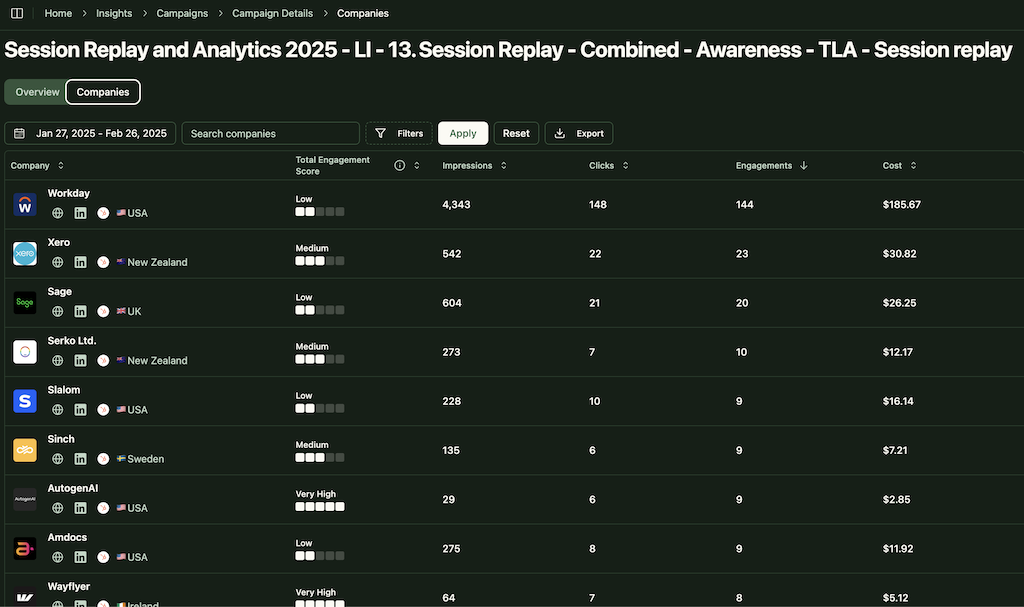
ZenABM connects to the LinkedIn Ads API to pull company-level engagement per campaign and campaign group, including impressions, clicks, and other interactions.
You get clarity such as Company X saw Ad A five times, saw Ad B three times, and clicked Ad B once. Native UI does not provide this campaign-level, company-specific breakdown. ZenABM fills that gap with first-party, compliant data, not scraping.
Real-time engagement scoring

The platform calculates an Engagement Score per account from LinkedIn signals, with recent and lifetime variants. The score updates as new data arrives, so a midweek surge appears midweek.
Automatic CRM sync
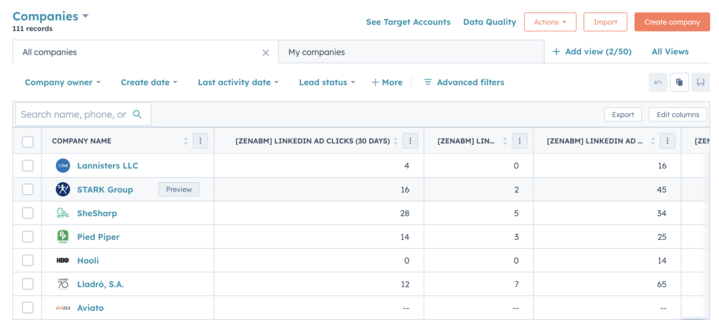
All metrics and scores write back to your CRM as company properties without manual work, using built-in sync. You can filter lists, trigger workflows, and build reports with those fields. The sync is continuous and bi-directional, so CRM stays current.
BDR alerts and routing

ZenABM alerts reps when an account crosses a threshold or stage. You can auto-assign unowned hot accounts to a BDR once the score qualifies as Interested, or whatever label you prefer.
Buyer intent tagging
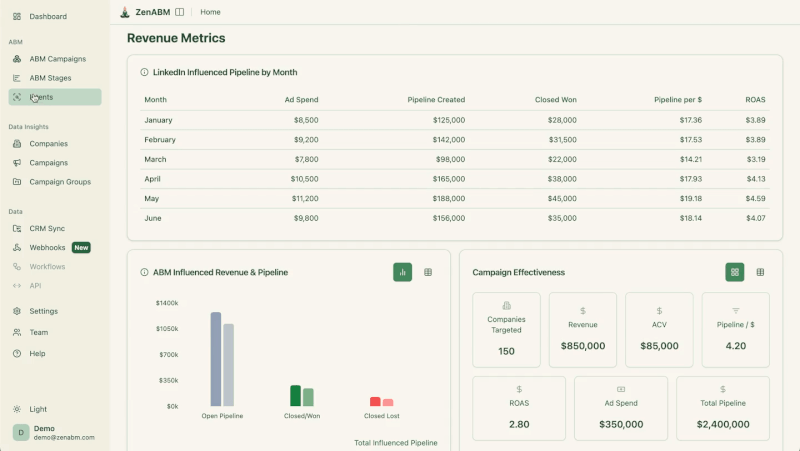
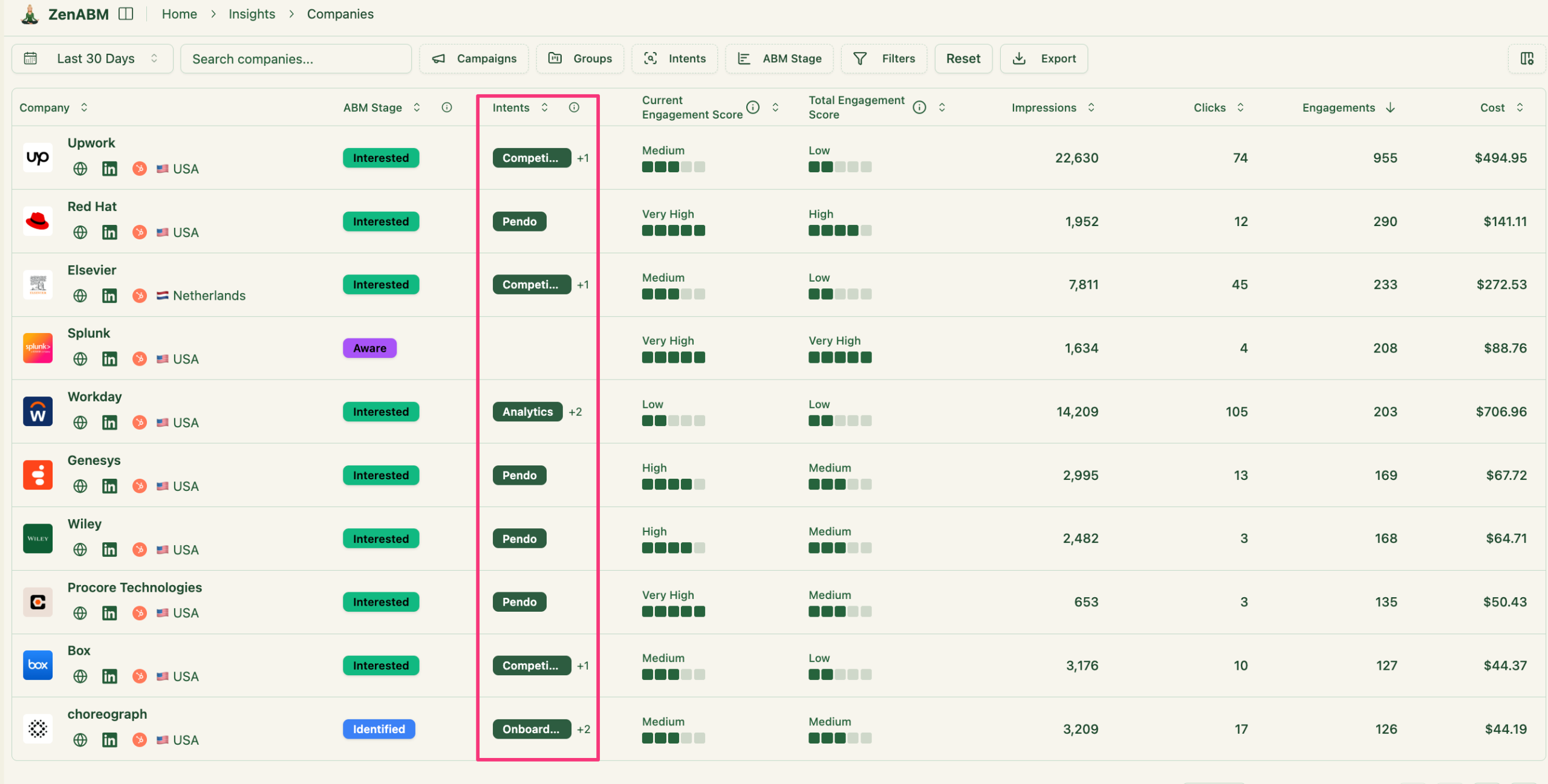
Tag each LinkedIn campaign or group with a theme such as feature, problem, or solution area. ZenABM clusters engaged companies under those tags and syncs the interest flag to your CRM, which gives reps instant context for outreach.
ABM funnel stage tracking

Set thresholds for stages such as Aware, Interested, Considering, and Selecting. ZenABM advances accounts using LinkedIn and CRM signals and lets you fine-tune the criteria.
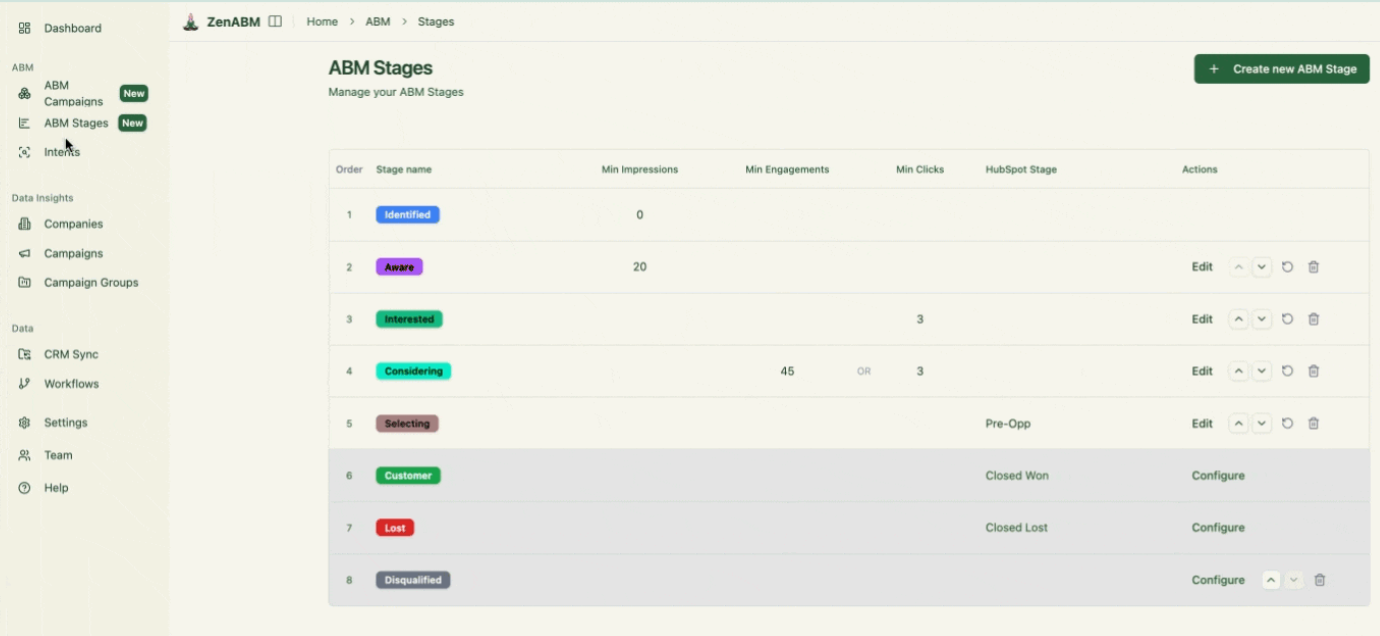
Full-funnel revenue attribution and reporting dashboards

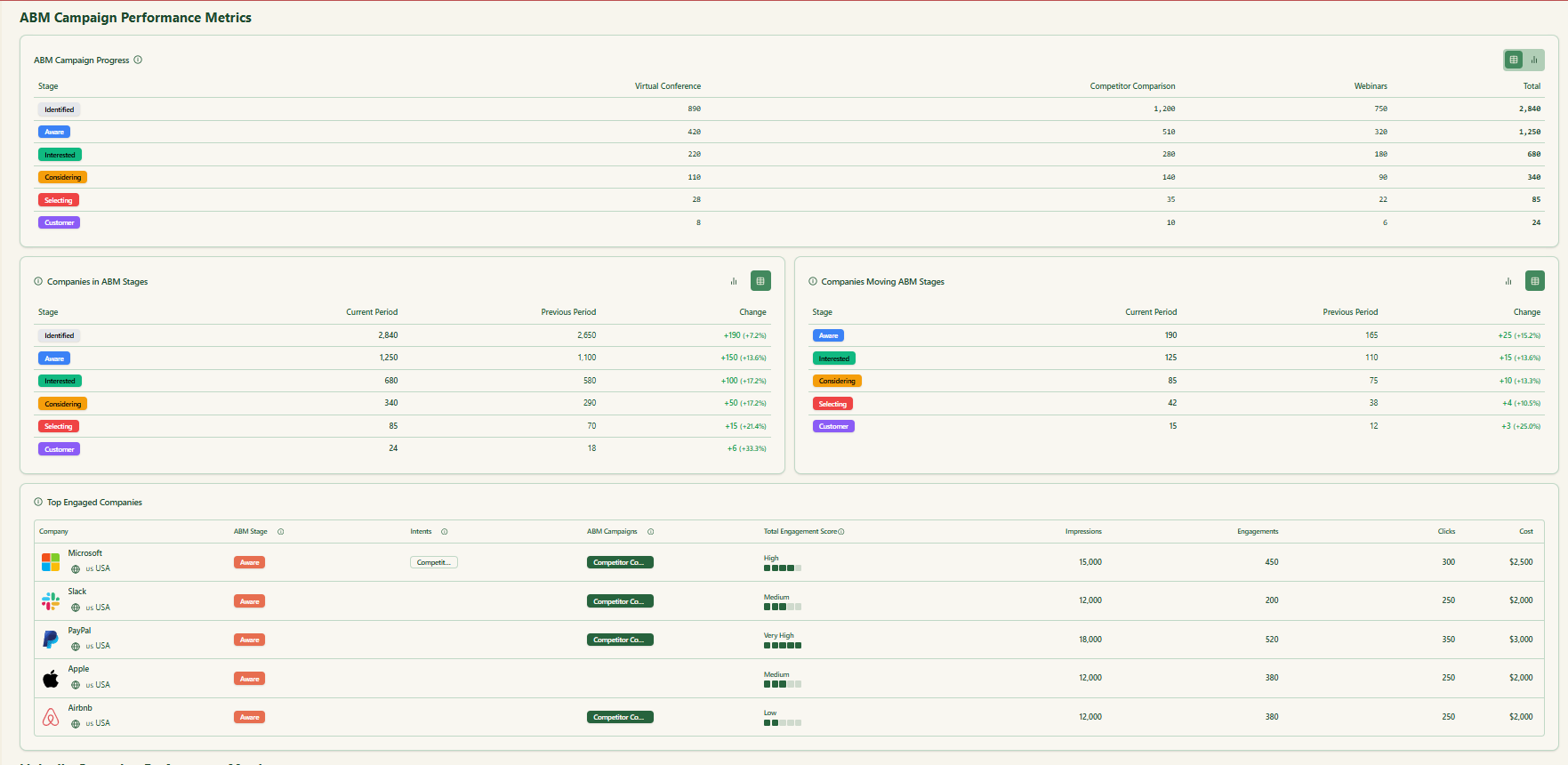

Because ZenABM connects LinkedIn with your CRM, it ties ad interactions to pipeline and revenue. You can see which accounts viewed or clicked the ads and later became opportunities or closed customers.
Dashboards include Pipeline per Account, Pipeline per unit of ad spend, ROAS, and top engaged accounts by stage. You score accounts for sales and prove impact to leadership in the same view.
Conclusion: turn LinkedIn signals into a working score
LinkedIn ad analytics is buyer intelligence, not only channel math.
For ABM, every view or click is an account signal. Use account scoring from LinkedIn ad data to decide who to engage, when to reach out, and what to say. Lead-focused metrics overlook this reality, while company-level data fixes prioritization.
Close the loop. Pipe the data, run a simple model, set alerts, and move fast when a target warms up.
Want an out-of-the-box path to account scoring on LinkedIn signals?
Try ZenABM now for free or book a demo to learn more.

